Counting Cards in Blackjack
Most casino games rarely allow you to tilt the odds in your favor, but counting cards in blackjack enables you to do precisely this.
The art of card counting consists of tracking the ratio of high to low cards remaining in the deck, giving you a strategic edge over the house, as a deck with more high cards boosts your chances of winning.
Counting cards is surprisingly simple, and in this guide, I’ll cover all of the basics, introduce you to some of the most popular methods, and discuss the pros and cons of these strategies to help you succeed.
Table of Contents
Improve your Blackjack game
Card Counting Basics
The core premise of card counting is keeping track of all previously played cards so you know what remains in the dealer’s shoe.
A higher density of these cards increases the chances of the dealer busting and your likelihood of hitting a Blackjack while allowing for more strategic doubling and splitting.
Players have developed different card-counting systems over the years to give you a better idea of the value of the next card in the deck.
So, how do you determine when you’re more likely to see specific cards and, in turn, when to raise your bets?
The count increases as more low cards get removed from the deck or shoe. The count decreases when more high cards are played than low ones.
The higher the positive count, the more high-valued cards we know remain in the shoe. The greater the positive count, the better chances you have to win.
Is It Legal?
According to local, state, and federal laws, card counting is allowed and legal in the United States. However, casinos reserve the right to refuse service.
In popular gambling destinations like Las Vegas or Atlantic City, if they believe you are counting cards, they will ask you to stop playing.
Some venues will still let you play other games but won’t let you play blackjack anymore.
If a casino is particularly unhappy with you, they can read you the tresspass act, which makes it illegal for you to be on their property.
Additionally, players cannot use assistive devices, have someone assist, or communicate information to other players that would give them an advantage.
How to Count Cards | Guide With Examples
As mentioned above, the main goal of card counting is knowing what remains in the dealer’s shoe.
To simplify that, you only focus on the value, not the suit. But how do you apply this information?
As gameplay progresses, you’re taking in all the available information and using some simple math to determine the best time to deviate from the basic strategy.
This step-by-step guide shows you exactly how card counting in blackjack works from start to finish.
The example uses the Hi-Lo system, one of the easiest and most popular methods.
Assign a Value to Each Card
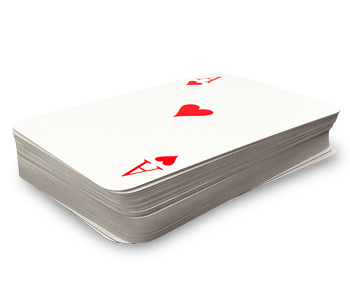
In all blackjack card counting systems, each card in the deck gets a positive, negative, or zero value.
These values help determine if the shoe has a higher concentration of low or high cards.
Having that extra level of foresight gives you an edge over the house.
Hi-Lo Assigned Card Values
The card values in the Hi-Lo card counting system are as follows:
- 2, 3, 4, 5, and 6: +1
- 7, 8, and 9: 0
- 10, J, Q, K, A: -1
Keep Track of The Running Count
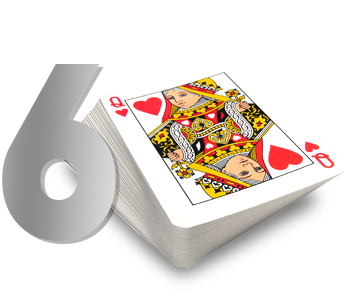
At the beginning of the shoe, you start with a count of zero.
When the dealer passes out the first card to you or another player, you add or subtract its value.
A negative number means subtracting, and a positive number means adding.
The number you get after the first card is your new running count.
With each consecutive face-up card, you add or subtract its value from your most recent running total to get a new count.
You continue the process with every card you see until the dealer shuffles the cards or gets a new shoe.
Hi-Lo Count Example
You’re at a table with two other players, the dealer, and a new shoe. Below, we’ll see how your count moves with each card that comes out of the shoe.
- The count starts at 0.
- You get a 6 (+1). The count is now at +1.
- The other players get a Jack (-1) and a 7 (0), bringing the running count down to 0 again.
- The dealer shows a King (-1). The running count goes to -1.
- Your second card is a 9 (0), leaving the running count at -1.
- The other players get a 4 (+1) and a 6 (+1), bringing the current count up to +1.
- The dealer gets a face-down card, so you don’t adjust the count for that yet.
- You hit, get a 10 (-1), and bust. The running count goes to zero.
- The first player hits for a 4 (+1) and stands. The second player hits, gets a 9 (0), and stands. Now the count goes up to +1.
- The dealer turns over their face-down card. It’s a 4 (+1). They hit based on house rules and get another 4 (+1) before standing. The running count goes up two points to +3.
- The dealer determines the winners and losers and clears the cards from the table.
- The +3 count we got at the end of the first hand carries over and is the number you start with for the next round.
Calculate the True Count
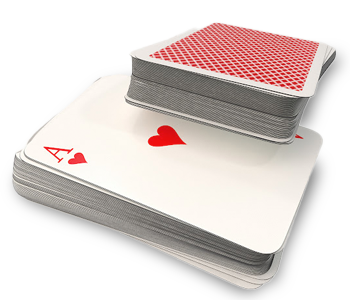
Casino Blackjack usually employs more than one deck at a time, complicating things for card counters.
The true count is an adjusted number that gives you a more accurate idea of the concentration of the high-value cards remaining in a multi-deck game.
You obtain it by dividing the running count by the number of decks remaining in the shoe.
As cards deplete from the shoe, there are fewer and fewer decks remaining. That means you must adjust the number you’re dividing by as the discard pile grows.
Hi-Lo True Count Example
Let’s say the example above is at a table with six decks in the shoe. Below are the true count formulas you would use throughout the game.
- At the end of the first hand, we determined the running count was +3. Since most of the six decks remain, we divide the count by six. +3 / 6 Decks = A true count of +0.5
- After ten hands, the count tripled, going to +12. By now, about two decks of cards have depleted from the shoe. With only four decks remaining, we divide our running count by four. +12 / 4 Decks = A true count of +3
Use The True Count to Adjust Your Bets

To take full advantage of a favorable shoe, you should adjust your bets as the true count changes.
There is a formula to calculate the recommended wager anytime the true count exceeds +2.
To get the recommended wager, take the current true count minus one and multiply that by your standard betting unit (usually 1% of your total bankroll).
Just remember, you’re always betting at least one unit.
Hi-Lo Bet Adjustment
Sticking with the examples above, we’ll assume your base betting unit is $5 per hand and use the suggested bet formula to figure out your next wager.
- The first true count was +0.5. Since +0.5 is less than +2, you would continue to bet one standard unit, or $5.
- After ten hands, we got to a true count of +3. Since +3 is greater than +2, we use the betting formula.
True count of 3 – 1 = 2 and 2 x $5 standard bet = a $10 recommended wager.
Pro Tips
You can do a few things to help avoid having the casinos detect that you are counting cards. Anything you do to deceive the casinos is called camouflage. So here are our top tips to make your card counting camouflage near perfect.
Play at Different Casinos
Pro card counters rotate casinos regularly to avoid too much attention from one establishment. Don’t spend hours and hours counting the same games because, eventually, the casino will figure out what you’re doing.New Shoe vs. In-Play Shoe
Many pros like getting a count before they sit down, but that can raise a red flag. Consider mixing up when you enter a game to prevent alerting the pit bosses to your advantage play tactics.Stick to Single Deck Games If You’re New
If you’re new to card counting, stick to single-deck games. A running count is all you need when there’s only one deck in play since you only divide by one for a true count, getting the same value as the running count.Set Your Standard Betting Unit at The Table Minimum
Managing your bankroll in blackjack is an important part of the strategy. When counting cards, you must have enough money to cover a streak of losses.
I suggest setting your standard betting unit at the table minimum and buying in with at least 100x that amount.
Popular Blackjack Card Counting Systems
There are dozens of card counting systems that blackjack players use to gain an edge over the house. They consist of single or multi-level methods, balanced counts, and unbalanced approaches.
The changes usually include specific card value shifts or a slightly different way to calculate the running or true count from one to the next.
Play with a few of them to determine which works best for you.
Balanced Counts
A balanced counting system starts at zero with a new shoe and ends back at zero when all cards have been played. The most popular example is the Hi-Lo method.
Below is a list of balanced card-counting systems used in blackjack.
Hi-Lo
The Hi-Lo system is the most commonly used card-counting method.
It is easy to learn and excellent for beginners.
| Card | Count Value |
|---|---|
| 2 | +1 |
| 3 | +1 |
| 4 | +1 |
| 5 | +1 |
| 6 | +1 |
| 7 | 0 |
| 8 | 0 |
| 9 | 0 |
| 10 | -1 |
| J | -1 |
| Q | -1 |
| K | -1 |
| A | -1 |
Hi-Opt I
The first Hi-Opt system is only a slight variation of the Hi-Lo method.
Another relatively simple way to count.
| Card | Count Value |
|---|---|
| 2 | 0 |
| 3 | +1 |
| 4 | +1 |
| 5 | +1 |
| 6 | +1 |
| 7 | 0 |
| 8 | 0 |
| 9 | 0 |
| 10 | -1 |
| J | -1 |
| Q | -1 |
| K | -1 |
| A | 0 |
Hi-Opt II
Hi-Opt II is a multi-level count meaning some cards are worth ±2 at a time.
It is a more advanced technique.
| Card | Count Value |
|---|---|
| 2 | +1 |
| 3 | +1 |
| 4 | +2 |
| 5 | +2 |
| 6 | +1 |
| 7 | +1 |
| 8 | 0 |
| 9 | 0 |
| 10 | -2 |
| J | -2 |
| Q | -2 |
| K | -2 |
| A | 0 |
Omega II
The Omega II method is a multi-level counting system. Some counters find it to be more efficient than Hi-Lo.
| Card | Count Value |
|---|---|
| 2 | +1 |
| 3 | +1 |
| 4 | +2 |
| 5 | +2 |
| 6 | +2 |
| 7 | +1 |
| 8 | 0 |
| 9 | -1 |
| 10 | -2 |
| J | -2 |
| Q | -2 |
| K | -2 |
| A | 0 |
Zen Count
The Zen Count is a two-level card counting system often employed by intermediate or advanced players.
| Card | Count Value |
|---|---|
| 2 | +1 |
| 3 | +1 |
| 4 | +2 |
| 5 | +2 |
| 6 | +2 |
| 7 | +1 |
| 8 | 0 |
| 9 | 0 |
| 10 | -2 |
| J | -2 |
| Q | -2 |
| K | -2 |
| A | -1 |
Wong Halves
The Wong Halves system is not for the faint of heart. It’s a complicated counting method used by the pro.
| Card | Count Value |
|---|---|
| 2 | +0.5 |
| 3 | +1 |
| 4 | +1 |
| 5 | +1.5 |
| 6 | +1 |
| 7 | +0.5 |
| 8 | 0 |
| 9 | -0.5 |
| 10 | -1 |
| J | -1 |
| Q | -1 |
| K | -1 |
| A | -1 |
Unbalanced Counts
Unlike the balanced formats above, an unbalanced card counting system doesn’t end up back at 0 by the end of the shoe. The most popular example is the Red-7 method.
Below is a list of unbalanced card counting systems used in blackjack.
Red 7
In the Red 7 system, not all sevens are equal. The black sevens are still neutral, but the red ones count as +1.
| Card | Count Value |
|---|---|
| 2 | +1 |
| 3 | +1 |
| 4 | +1 |
| 5 | +1 |
| 6 | +1 |
| 7 | Red +1 / Black 0 |
| 8 | 0 |
| 9 | 0 |
| 10 | -1 |
| J | -1 |
| Q | -1 |
| K | -1 |
| A | -1 |
Knock Out
The knockout system alters the Hi-Lo count by counting the 7s as low cards, giving them a +1 value.
| Card | Count Value |
|---|---|
| 2 | +1 |
| 3 | +1 |
| 4 | +1 |
| 5 | +1 |
| 6 | +1 |
| 7 | +1 |
| 8 | 0 |
| 9 | 0 |
| 10 | -1 |
| J | -1 |
| Q | -1 |
| K | -1 |
| A | -1 |
KISS
The KISS method (Keep It Simple Stupid) is a simplified Hi-Lo count that gives you three fewer cards to track.
| Card | Count Value |
|---|---|
| 2 | 0 |
| 3 | 0 |
| 4 | +1 |
| 5 | +1 |
| 6 | +1 |
| 7 | 0 |
| 8 | 0 |
| 9 | 0 |
| 10 | -1 |
| J | -1 |
| Q | -1 |
| K | -1 |
| A | 0 |
Use the Hi-Lo Strategy If You’re New
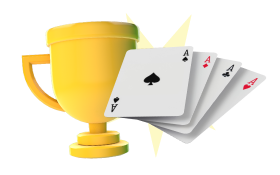
The Hi-Lo strategy is the most recommended card counting method for novice to intermediate players.
In my opinion, this system strikes a good balance between simplicity and effectiveness, making it accessible for beginners while still being powerful enough to improve your odds.
I recommend starting with this system because it provides a solid foundation for understanding card-counting principles, and you can learn it with practice and dedication.
Blackjack Card Counting Strategies
Once you know the process and get good at keeping track of everything, you can apply several additional strategies while counting cards.
Deviations and Indexes
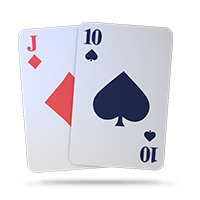
Aside from simply increasing your bet as the shoe changes, most card-counting systems have additional strategic plays to consider.
Deviations and indexes, sometimes called index plays, are the suggested specific moves that differ from the basic hit/stand charts.
When you factor in the true count and compare your hand to the dealer’s up card, there are certain instances that you want to change up when to hit, stand or double.
Many systems even have their own diagrams to show you the best play for the current situation.
The Illustrious 18 | A Popular Strategy
Blackjack hall of fame and gaming mathematician Donald Schlesinger affectionately called a set of efficient strategic deviations The Illustrious 18, and the name stuck.
The table below shows you all of those moves.
| Illustrious 18 | Hand & Dealer Card | Index Count | Move to Make |
|---|---|---|---|
| 1 | Insurance on Dealer A | +3 | Take insurance when +3 or higher |
| 2 | 16 against a 9 | +5 | Stand at +5 or higher |
| 3 | 16 against a 10 | 0 | Stand at 0 or higher |
| 4 | 15 against a 10 | +4 | Stand at +4 or higher |
| 5 | 13 against a 2 | -1 | Stand at -1 or higher, otherwise hit |
| 6 | 13 against a 3 | -2 | Stand at -2 or higher, otherwise hit |
| 7 | 12 against a 2 | +4 | Stand at +4 or higher |
| 8 | 12 against a 3 | +2 | Stand at +2 or higher |
| 9 | 12 against a 4 | 0 | Stand at 0 or higher |
| 10 | 12 against a 5 | -1 | Stand at -1 or higher, otherwise hit |
| 11 | 12 against a 6 | -1 / -3* | Stand at -1 (-3 if the dealer hits on 17) or higher, otherwise hit |
| 12 | 11 against an Ace | +1 / -1* | Double down at +1 (-1 if the dealer hits on 17) or higher |
| 13 | 10 against a 10 | +4 | Double down at +4 or higher |
| 14 | 10 against an Ace | +4 / +3* | Double down at +4 (+3 if the dealer hits on 17) or higher |
| 15 | 9 against a 2 | +1 | Double down at +1 or higher |
| 16 | 9 against a 7 | +4 | Double down at +4 or higher |
| 17 | Pair of 10s against a 5 | +5 | Split at +5 or higher |
| 18 | Pair of 10s against a 6 | +5 | Split at +5 or higher |
Team Strategies

Another popular strategy is team play. The goal is for the whole group to make money, with each person executing a specific role.
A “counter” sits at a table or observes the game from behind seated players, indicating a favorable count or passing the current count to other teammates.
They are here to gather info, and if playing, always bet the table minimum.
The “big player,” sometimes called a gorilla, only sits down at tables with high positive counts after they have gotten the signal. They bet huge immediately and keep it up until the count falls back.
Some teams also utilize a “spotter” to gather more information and watch the action of employees in the pit.
Any data the team gathers could be valuable in beating the house.
Blackjack Card Counting Practice
The easiest way to start learning a card counting system is to grab a deck of cards, shuffle them, and flip them over one by one.
It will be a slow process initially as you reference the system’s table and try to remember everything.
The goal here is to memorize each card’s value and keep a running count throughout the entire deck. Once you have that down, you can work on picking up the pace, eventually turning over two, three, or four cards at once.
After you masters counting a single deck, you work your way up to six or eight decks.
Since a casino will be full of noise and commotion, it’s also a good idea to eventually incorporate distractions like a TV or radio into your practice.
Learn to Count Playing Free Online Blackjack
A free blackjack game is a great way to start practicing your card counting system. As you play a hand, try to quickly get the count based on the cards you can see.
Remember, the shoe here doesn’t matter since you’re just trying to gather the info for a single hand.
The faster you get, the better you will be at factoring in several hands at a live table and keeping the running count in your head.
Practice With a Live Dealer
Live casino games have real human dealers, making them an excellent intermediate step between solo practice and traveling to a casino floor.
You can find virtual tables with lower minimum bets that allow you to stretch your bankroll and play for longer while placing real money bets.
Live dealer blackjack is played from dedicated studios and is live-streamed to any device, allowing you to play from anywhere.
Internet play lets you keep charts and tables handy and removes a lot of distractions.
You’ll be able to learn from mistakes in a less costly and less time-consuming manner than if you were to visit a land-based casino.

The Pros and Cons of Card Counting
Card counting can be a double-edged sword. On the one hand, it offers the opportunity to tilt the odds slightly in your favor, leading to potential profits over time.
On the other, casinos are vigilant about spotting card counters and have measures in place to hinder this strategy.
Moreover, mastering this skill requires significant practice and focus, which can be mentally exhausting.
If you’re unsure about employing this tactic, consider the following pros and cons.
Pros
- Increased Winning Odds: You can make more informed betting decisions, increasing your chances of winning.
- Skill-Based Advantage: Unlike pure luck games, card counting leverages skill, giving you a strategic edge.
- Minimal Financial Risk: Like other gambling strategies, card counting doesn’t require a significant upfront investment.
- Enhanced Game Engagement: The challenge of counting cards can make Blackjack more engaging and intellectually stimulating.
Cons
- Casino Countermeasures: Casinos use techniques to detect and counteract card counters.
- High Mental Demands: Counting cards requires intense concentration and mental arithmetic, which can be exhausting.
- Learning Curve: Mastering card counting is complex and requires substantial practice and dedication.
- Ethical and Legal Concerns: While not illegal, card counting is frowned upon by casinos, and if caught, you risk being banned.
It Doesn’t Work Well Online
You can and should use online blackjack games to learn how to count cards and gain experience, but you won’t gain much advantage.
Online casinos have made card counting nearly impossible. In software-based games, the virtual cards get shuffled at the end of every hand, so you’ll never get a running count.
Even the live dealer blackjack games know about card counters and take measures to avoid losing money. Many studios shuffle at 50% of the shoe, which makes it hard to get a good read, so proceed with caution.
Consider Pursuing Card Counting If…
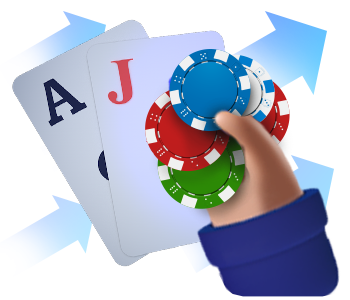
If you enjoy Blackjack and want a way to gain a strategic edge, consider pursuing card counting.
In my opinion, this tactic is best suited for disciplined, patient players who have a strong grasp of basic Blackjack strategy and are willing to invest time in practice.
You should also be comfortable with the mental demands of keeping track of the cards while maintaining a low profile to avoid detection by the casino.
I recommend card counting for those who find intellectual challenges rewarding and are serious about improving their long-term odds rather than casual players looking for quick wins.
If you’re ready to put in the effort and handle the risks involved, card counting can be a valuable addition to your blackjack strategy toolkit.
Frequently Asked Questions
Although I’ve covered blackjack card counting thoroughly and comprehensively, I’ll round off the article by answering some outlying questions commonly asked by players.
Is blackjack card counting different from counting cards in poker?
Card counting is used for different purposes in blackjack and poker. In blackjack, people count cards to give themselves an advantage over the house and will bet high when they have an advantage and low when the dealer does. In poker, counting cards help determine what decisions to make against other players.
How to win at blackjack without counting cards?
You don’t need to count cards to win at blackjack. The best thing you can do is practice and learn how to use the basic strategy chart.
Can you make a living with card counting?
It’s questionable if you can make a living card counting. People make careers out of playing blackjack, but it may be unrealistic for the average gambler if casinos start backing them off of tables or banning them from playing.
How often do you win when counting cards?
A good blackjack card counter gains around a 0.5-1% edge against the casino. That means you’re winning just over half of the time and can still encounter losing streaks and bad deck variance.
